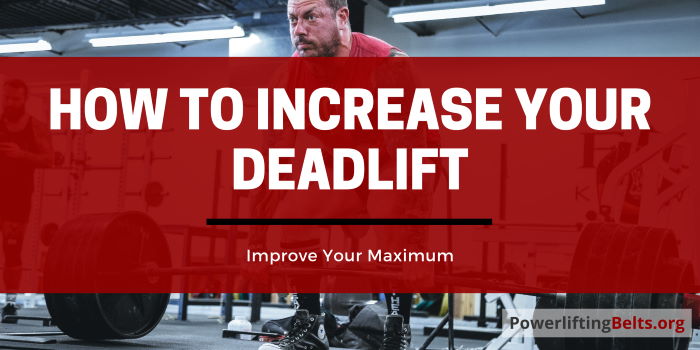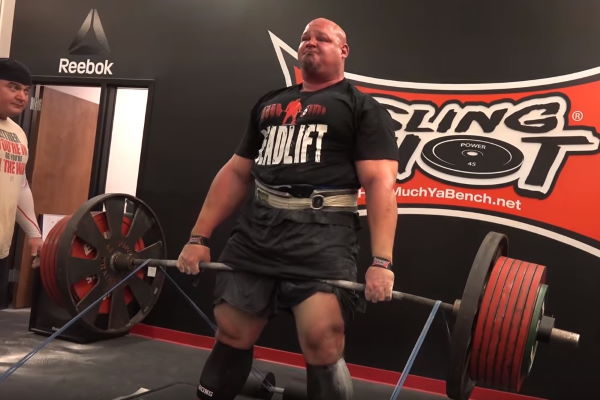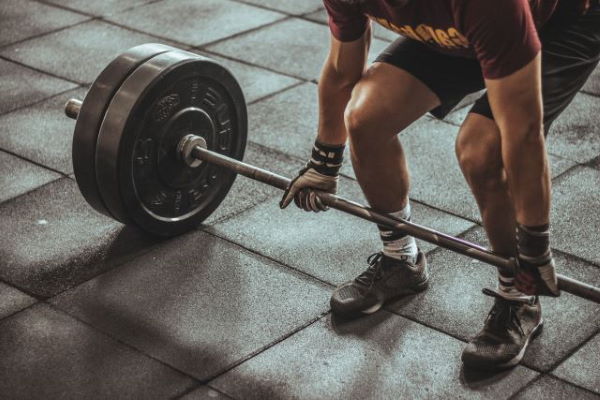
Deadlifts are a great test of strength…
It’s just you, the barbell, and a couple of weights…
There’s no way to cheat (like bouncing the bar from your chest on the bench press), either the bar leaves the floor, or it doesn’t.
But often, performing the conventional deadlift is a guessing game for many. We all know at least one person who has hurt their back doing this exercise.
You don’t need to be a strongman or professional powerlifter to look at ways to improve your deadlifting performance or improve your 1 rep max.
There’s a whole world in strength training for this particular exercise.
This article will provide you with a couple of strategies and tips to increase your deadlift max plus to improve your form overall.
11 Tips To Improve Your Deadlift
#1 – Do More Deadlifts
Firstly, if you’re not actually deadlifting (or a variation) or only performing them once or twice a month, then it’s time to take more time to do them, you can’t expect to make much progress or see an improvement.
It is possible to use other deadlift strengthening exercises to improve.
But remember, nothing can beat actually lifting the barbell from the floor regularly.
#2 – Overtraining & Recovery
You can be lifting too often! If you are deadlifting more than once or twice a week, there’s a good chance that you are overdoing it. By performing the same lift too often, your body will struggle to recover to get stronger and you may be increasing your risk of injury. Improving your deadlift strength takes time and requires rest time for your body to recover.

Experimenting with taking different rest periods between each training sessionis a good way to find the perfect recovery time. This is the most efficient way to make fast progress in your deadlift program.
Also, keep your diet in check. Be sure to consume enough calories to support muscle gains and build strength.
#3 – Switch Variations
A great way to break through a plateau is to switch your deadlift variations. If you usually lift in the conventional style, then try sumo style or Romanian deadlift for a few weeks and switch back.
Likewise, if you are used to sumo deadlifts with a shorter range of motion, then switch to conventional. Alternating between the variations while keeping a good form is a great way to make gains and keep your routine interesting.
#4 – Exercise Your Grip Strength
A strong grip generally means all-around body strength. If you don’t have a good grip then you cant make complete use of your strength or muscle mass. A stronger grip also improves your confidence in lifting and almost tricks your mind into believing that you can move the weight.
Some great grip training exercises include static holds, farmer’s walks and making use of fat bars (or Fat Gripz).
Try out different grips to see what is best. Be sure to try an overhand grip and a mixed grip.
#5 – Try Out Different Grips
There are generally 2 types of grip used for deads. They are:
- Overhand grip
- Mixed grip
The overhand grip is great for beginners. But once you start lifting heavy, you’ll soon have a problem with the bar slipping from your hands. To combat this, try out the mixed grip.

This is simply having:
- 1 hand in the overhand position
- 1 hand in the underhand position
This works much better because you have each hand supporting the other where you would normally only have your thumb in the overhand grip. So it reduces the likelihood of the bar from falling from your hands when your grip starts to fatigue.
Be sure to switch your hands with each set so you don’t have an imbalance.
Personally, I use a normal overhand grip for
#6 – Workout With Squats
Powerlifters might say that improving your deadlifts won’t help with your squats. But Squats can certainly help your deadlift max. Since squats require such raw strength, moving big weights in the squats usually means impressive lifts all around. This universal strength translates well to the conventional deadlift and posterior chain strength.
By adding an extra 25kg to your squat, will likely see improvements in your other lifts too!
Other good exercises to try adding to your program include heavy rack pulls to build power These are a great way to get some heavy weights in your hands. If you are finding that you are weak off the floor, try adding deadlift deficits to your routine.
#7 – Bend The Bar
As you are lifting, try to bend the bar. This makes you employ the lats to keep the bar closer to your body.
To emphasize this, attempt to also pull the bar up and close to your body during the deadlift movement.
This is simple physics. By having a weight closer to your center of gravity, it will be easier to lift.
#8 – Take Your Shoes Off And Go Barefoot
Unless you are wearing good weightlifting shoes or footwear with very little cushioning, then try taking them off. Especially, if you are wearing running shoes or sneakers. Not only will you have less distance to move the bar, but the force will transfer directly through your feet to the floor with no cushioning absorbing that force.

Stability is also improved by removing your shoes. Too much cushioning (as found in most sneakers) increases the chance of you being off-balance through the deadlift. For these reasons, it’s quite common to see lifters going barefoot for their deadlift workout and for squats. There are a variety of female lifting shoes as well as those designed for men which are a great alternative to going barefoot.
#9 – Try Increasing Your Reps
At the end of a high-volume deadlift session, try adding a set of higher (8 to 12) reps. These work well because your muscles will already be fatigued and your body will learn the optimum technique for lifting the weight while keeping a good deadlift form.
These should be with lighter weights and a reasonably light volume, they don’t need to be heavy sets for the best effect, drop the bar at the top of the rep or lower it, let go and stand up to reset yourself each time.
#10 – Wear A Lifting Belt
If you’ve been lifting for a while, there’s a good chance that you’ve already developed some strong core strength and the breathing and bracing techniques to increase intra-abdominal pressure. So wearing a belt is a near-guaranteed way to instantly add extra weight onto your max. There are unisex belts and workout belts for ladies, just be sure it doesn’t become a crutch that you rely on too much!
#11 – Rock Backwards
Usually, if you bend your body during the middle of an exercise, it can mean that you are lifting too much weight. However, with deadlifts, this can give you a new max lift.
If you train yourself to almost fall backward when performing a lift, you can position your body to produce more power. Many professional lifters use this technique to hit and exceed their maximum weight.
The Technique
You should stand with the bar at your feet in the same kind of position as you would perform a jump, keeping your lower back in a natural arching position. Then reach down and grab the bar with your hands roughly shoulder-width apart.
Ideally, your shoulders will be directly over the bar or maybe slightly behind the bar in a neutral position and you should be looking straight ahead.
The technique now is to rock back onto your heels so that you become slightly off-balance. As you push your feet into the floor, you begin the pull and you should be feeling as though you’re falling back a little.

When you get to the point when the bar is past your knees, you should move your head back so your chin points upwards. You may stumble a little during warm-ups when using a lightweight, but once you train with this technique and move onto the heavier weights, the weight acts to balance you.
Most beginner and intermediate powerlifters will try to pull the bar directly upwards when in fact they should be thinking about pulling it upwards and backward too.
By adjusting your center of gravity back, the hamstrings, lower back and glutes are placed in a more powerful position. This allows them to extend their hips easier.
#12 – Progressive Range Of Motion
An interesting technique used by a few lifters is a progressive range of motion or progressive movement training. Usually, when we lift, we usually think of 3 variables that we can adjust to make progress:
- Volume – More reps or sets.
- Intensity – More weight.
- Density – Work faster.
But another variable that can be thrown into the mix is the range of motion…
For example, say you usually squat 300lbs and stop when the hips are parallel to the knees, you can increase your range of motion until you are right at the bottom until your hamstrings cover your calves.
For deadlifts, we can do this the other way. You can add more weight and reduce the range of motion to create some progressive overload.
- Say you normally lift 300lbs from the floor.
- You can try lifting 310lbs from the height of the shins.
- Then you gradually work on increasing your range of motion with that weight.
FAQs
What’s a good deadlift max?
The top lifters will have a max of around 260% of their body weight. Advanced lifters will deadlift around 200% of the body weight.
How much can you increase your deadlift in a year?
A new lifter will increase their deadlift much quicker than an experienced one who is already lifting a reasonable amount of weight. With the correct strength training program, a good average increase is around 100lbs in a year.
What exercises increase deadlift?
Exercises that improve your deadlift max include pendlay rows, rack pulls, and variations such as sumo or Romanian styles.
How many reps and sets of deadlifts should you do?
Deadlifts are a strength exercise so should be performed at a lower number of reps. Generally, you should do 3 sets of 5 reps. But these numbers vary depending on the lifter’s experience.
Should I do deadlifts on leg day?
Deadlifts can be included in your back or leg routine. It is down to personal preference but it’s important to consider recovery between sessions.
Are squats and deadlifts enough for legs?
Squats and deadlifts are a great formula for lower body strength and power. They are certainly enough for a good base but if you desire further leg strength or size then consider adding a wider range of exercises.
What is deadlift good for?
Deadlifts are a great compound exercise for building strength across the entire body. They help with body posture and help in injury prevention.
Conclusion
By practicing a few of these simple techniques you should be achieving a new maximum deadlift and also a stronger lift. When this is combined with a good weight-lifting belt, your max lift can go through the roof!
Leave A Comment